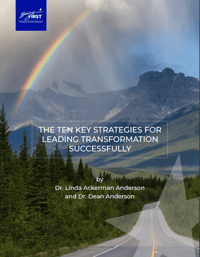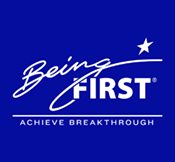A fundamental condition for success in your change efforts is a solid, co-creative partnership between your sponsor and project lead. Most executives recognize the importance of sponsoring major change efforts. However, the traditional approach to change sponsorship does not create an effective partnership in most cases. Why? What's missing?
Understanding Traditional Change Sponsorship
Traditionally, sponsorship entails naming a project manager, setting goals, determining the timeline, and providing adequate resources.
The sponsor holds the project lead accountable for the project's results. Not much interaction occurs between the project's beginning and end unless certain approvals are sought, or some crisis explodes.
The relationship between the sponsor and the project lead reflects the quality of the project's results.
This sponsorship model works adequately (not ideally) for developmental and transitional types of change, which by nature are more controllable and less apt to have complex human dynamics. Sponsors like the traditional model because it places minimal demands on them, and those demands are relatively easy to meet. Fewer demands are especially appealing if they are sponsoring many change projects, which many executives do.
Why Transformational Change Demands More from Sponsors
The traditional sponsorship model does not work for transformational change. Using it is a predictable condition for failure. Transformational change has unique dynamics and requirements that put special demands on the role of the sponsor. It is far more complex, being both less controllable and more emotional.
The change process in transformation is emergent—you must begin to change before you have a clear idea of where you're going. That means learning as you go, much of the time, changing your plans when you discover new information. Such an emergent process requires that the decision-makers stay involved, especially the executive sponsor. New information requires you to rethink your intended results, and adjust your scope, redesign your strategy or alter your implementation plan.
What Is Transformation? Why Does It Fail?
In this video, Co-Instructors Dr. Linda Ackerman Anderson and Dr. Dean Anderson explore what transformation is and why traditional approaches to change fail to address it properly.
What's Missing from Traditional Change Sponsorship
Transformation also triggers profound human dynamics. Because the actual changes can be so significant, so are the human reactions to those changes. Transformation requires that you alter both the leaders' and the workforce's mindset, behavior, and fundamental ways of working. These human dynamics make the change process that much more unpredictable and complex. They can trigger enough resistance and emotional reaction to cause you to rethink your scope, direction, communications, timetable, and plan.
Without doing so, your change effort will fail.
What's Needed from Transformational Sponsors
Your sponsor will need to be involved in the issues about the change strategy and the human dynamics to determine how to resolve them. Frequently, the causes of these problems lie in the sponsor's style, mindset, or interaction with the organization. If left out of the loop, your sponsor may not agree to the necessary actions necessary for success, especially if they mean some personal course correction!
In short, transformational change sponsors must be far more active in planning and overseeing their change projects. They must be more accessible, communicative, and open to learning about and altering their outcomes, strategies, and plans. They must be willing to renegotiate the timing, resources, and milestones for the project and be involved as necessary in repairing key relationships unintentionally damaged during the inevitable stress and confusion.
Please Note! We do not propose greater micro-management! This activity increase refers to "staying in the strategic saddle" of the effort in partnership with the project leader, who sees the initiative through to fruition and handles the details. It does not mean getting involved in the day-to-day. Transformational sponsorship simply requires ongoing attention to change strategy.
The bottom line for transformational sponsors is recognizing the unique demands of transformation and establishing a quality of partnership with the project lead
How to Create a Sponsor Project Lead Partnership for Transformation
As the change unfolds over time and process or people issues surface, which they will, the sponsor and project lead need to act as coaches to one another, regardless of the hierarchical position gaps between them. When they consciously create a solid and trusting relationship, they can speak openly and honestly and help each other look beyond their traditional beliefs or perceptions that blindside them from seeing what they need to do to correct their transformational reality in a timely way.
For maximum success, both your sponsor and the project lead must consciously create their partnership around:
- Shared responsibility for figuring out the best outcomes to pursue.
- Active and ongoing communications.
- Two-way coaching on how each person's mindset, behavior, and style affects project results.
- Delivering honest and useful feedback.
During project rollout, both must pay vigorous attention to happenings in the organization and its people and what is happening between them. Where the hierarchical differences between them need to be respected, nonhierarchical communications will bring them both—and the project—into the Winners Circle. The relationship between the sponsor and the project lead reflects the quality of the project's results.
The bottom line for transformational sponsors is recognizing the unique demands of transformation and establishing a quality of partnership with the project lead that will enable them both to deliver the results. Consequently, transformational sponsorship includes both a devotion to the project's outcomes and consciously building and sustaining a productive and mutually beneficial working relationship for the life of the change effort.
Related Webinar:
Sponsor-Project Lead Partnership Best Practices Proven to Maximize Transformation Results
Instructor: Dr. Linda Ackerman Anderson
This webinar explores a four-step process for creating an effective sponsor-project lead partnership and the proven principles that drive it. You’ll get our best practices and tips for building a sponsor-project lead partnership derived from our 40+ years as experts in leading transformation.
Featured eBook:
The Ten Key Strategies for Leading Transformation

Through 40 years of observing and supporting large-scale change and transformation in Fortune 500, government, global NGOs and public service organizations, we’ve identified these ten Best Practice strategies for leading transformation successfully.
Please complete the form to download your eBook:


